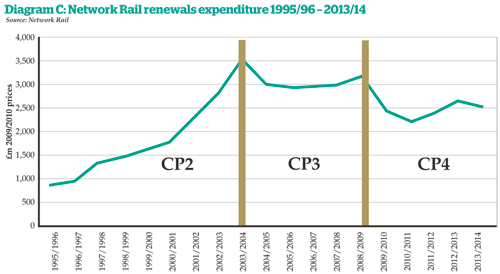The supply industry did not accept the view of the McNulty Report that the UK railway was around 40% less efficient than comparator railways in other countries. On the contrary, we identified good reason for thinking that the basis of that figure might not bear the weight of analysis being placed upon it.
This is important - having at the time of CP3 noted that very substantial cost savings were available, for CP4 and CP5 we urged a much more cautious approach. Few railways have managed to halve their costs in the way expected of Network Rail (see Diagram D, below), while maintaining or growing their outputs.
However, what is clear from our analysis is that project churn - the extensive, wasteful and endemic change to project scope, timing and content in the last few weeks before work starts on the ground - is wasteful of scarce resources, damages the quality of the industry’s offer to its customers, and should be brought urgently under control.
The membership surveys mentioned above have reflected infrastructure members’ frustration at Network Rail’s reluctance to engage more widely in the early stages of project development. The consensus is that significant efficiencies could be achieved if only Network Rail would embrace true collaboration in an open and constructive way with its supply chain partners. There is a huge willingness to share the collective experience, knowledge and competence in addressing the challenges that we all face.
In short, we urge you:
Don’t change the plan, scope, programme and parameters once agreed and published. BUT… do change the approach to the supply chain, and embrace what supply companies have to offer in an open and collaborative way.
There is much more to be said. The importance of stimulating the industry’s exports is crucial. At the same time, the strengthening of genuinely based client demand for innovation and the opening of routes to market (especially for SMEs) are essential moves if the industry is to prosper, grow and re-assume its previous position of global leadership.
Both the supply side and client side are facing tough challenges:
- Coping with major senior staff changes
- The consequences of reclassification, not least for the control of expenditure
- Trying to get more built in shorter timescales on an ever-more congested railway
- The advent of substantial technological change in the form of the Digital Railway
We both have a shared interest in the long-term future of the railway. We both depend upon it. Many supply companies, from small to multinational, have introduced major innovations on the railway, and there are more to come.
In short, RIA members should be seen not as part of the problem, but as part of the solution.
 Read the peer review for this feature.
Read the peer review for this feature.
Download the graph for this feature.












